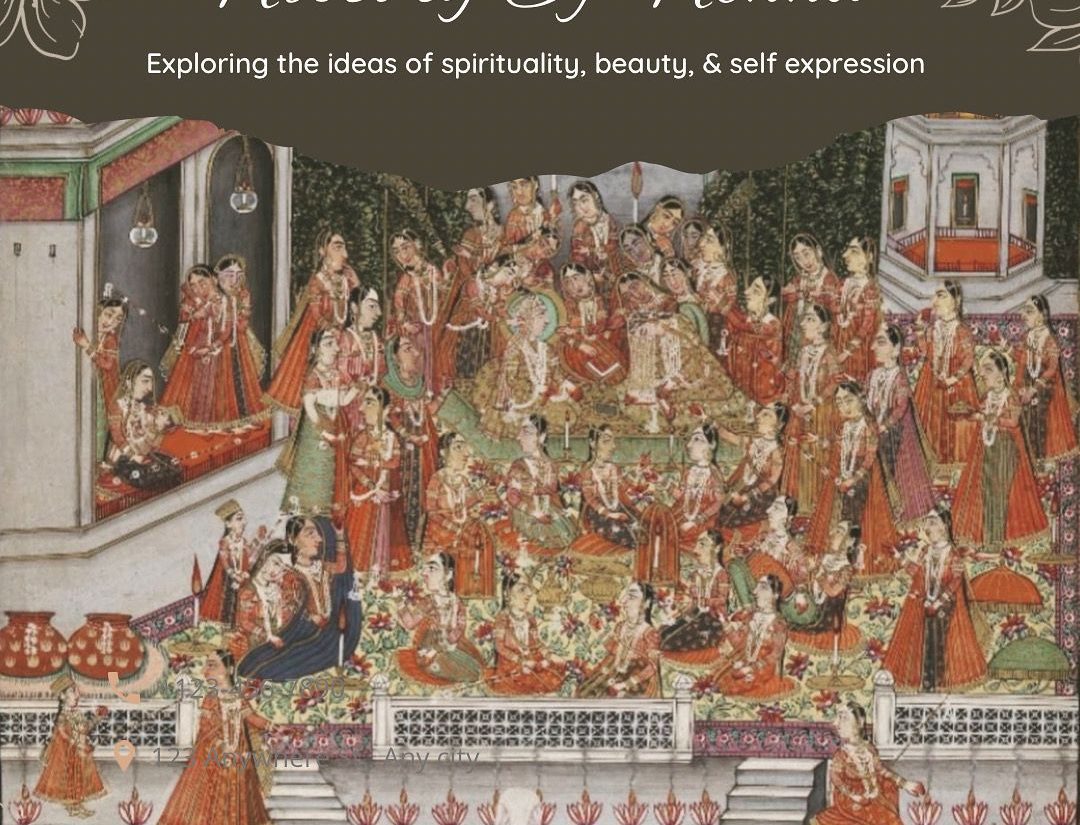
Article by EIH Art Researcher and Writer
Juhi Mathur
When we hear the word henna, or its more popular synonym mehndi, our mind automatically takes us back to those sleepovers with our friends, hours spent drawing ornate floral vines and orbs on each other’s palms, feet, and arms. Imitating elaborate mehndi designs from vintage 80s and 90s mehndi design books belonging to our mothers, aunts, and grandmothers. Moreover, any South Asian wedding is incomplete without a mehndi ceremony. Beyond the presence of Henna tattoos or henna-mehndi designs gracing our bodies, applying mehndi to graying hair has been part of a self-care ritual in South Asian households. In concise terms, henna has become an intricate part of our culture, and even more entwined with our rituals and customs. Charting its complex history in terms of its functionality provides us with a clearer picture of the ever-evolving beauty standards and trends governing our lives in silent ways. Like any other vernacular practice that is intricately and simultaneously tied to different civilizations, charting the history of henna in a linear format is not an easy task.
The henna plant, scientifically known as Lawsonia Inermis, has been in use for almost more than 9000 years. Its traces are found in the Egyptian courts growing in the arid lands near the river Nile, presumed to be part of the Sumerian and Akkadian art and rituals, stored in the condiment boxes by Iranian women, its fragrant perfumes traveling all the way to Moroccan alleyways as well as saturating the Indian bridal chambers and royal palaces.
The origins of henna are as multifaceted as its purpose, and every land tries to claim the origins of this enigmatic botanical. The henna plant is believed to have its origin stories tied to the Egyptian civilization, where their customary rituals, as well as beauty regimes, had henna as an ingredient. Another evident aspect is the absence of any import records of henna in Egypt, since the Egyptians are the first ones to use writing in the form of hieroglyphics, it is not surprising that the presence of henna was first recorded here. Mummies are the oldest remnants of henna, and the archaeological survey and studies have proved that the nails, hands, and feet of many mummies were stained with henna. The mummy of the Egyptian Pharaoh Ramses II has henna-stained nails and hands, adding a layered meaning to its purpose and its significance in the funerary practices. A more bona fide mention of henna is found in the text of Ebers papyri, which was written around 1500BCE, it is an Egyptian medical papyrus of herbal knowledge, indicating the medicinal properties of henna.
It was recorded that Cleopatra has all of her Niles barge sales soaked in henna oil/henna perfume known as Cyprinum, and she wore it when she met Mark Antony. Author Marie Anakee Miczak points out that the ideas of spirituality, smell, and pleasure were deeply interconnected with each other in Egyptian culture. Perfumes had more meaning and they were an important aspect of daily life. The henna oil/perfume was seen as a facilitator of healing and protection, in addition, to being aromatically pleasing, and was used as a mood enhancement. The concept of inhaling calming fragrant smells of botanicals and their exhilarating effects on low moods have been explored in Unani medicine. According to Pliny Elder and Dioscorides, Henna was popular for its pleasant fragrance, explaining the consumption of henna perfumes among the elites, focusing on the cultural significance of the plant.
In India, the mentions of Henna perfumes or attar are found in the old Indian epics, the earliest record of perfume making is found in Brihat Samhita, an encyclopedia authored by Varahamira in the 6th century AD. But the concept of attar or ittars became more prevalent with the arrival of the Mughals the production of atar or attar, became large scale from the sixteenth century AD. In the Ayurvedic texts, henna was used for the treatment of Chakras, mainly the crown chakra known as ‘Sahasrara’. The concoction consists of three teaspoons of attar of henna and seven teaspoons of neem oil. Emphasizing the spiritual and aromatic qualities of henna, particularly the henna oil, similarly in Egypt, the leaves of the henna plant were used to cure scorpion and snake bites. Hence, we learn about its inclusion in day-to-day lives that went beyond mere cosmetic usage. The spiritual facet of henna becomes more pronounced when we look at its role in the funerary practices in Egypt and certain Islamic communities. During the mummification process, henna was applied to the hands, nails, and feet of the body, and in certain Islamic customs, attar of henna or henna oil is applied to the forehead as a mark of protection.
Beyond its esoteric role, people of all genders found interesting ways to use henna cosmetically. Using distilled henna flowers for their anti-aging properties. In Kama Sutra, Vatsyayana even recommends henna as a red lip colour-
“The colour of lips can be regained by means of the madayantika (henna) and other plants mentioned”.
Henna’s cosmetic use and its subsequent inclusion in the wedding ceremonies, namely the henna-bandi ceremonies or Night of Henna is a concept that probably developed in the affluent societies of the civilizations where the institution of marriage itself was practiced. It is because the cultivation of henna and the production of henna oils and perfumes are expensive and time-consuming, thus applying henna and using it for beautification would be considered a symbol of luxury. In India, the association between wedding and henna or Mehendi ceremonies is a relatively newer practice. In mass culture, Mehendi means the body art created with henna, which is not completely false, the word Mehendi itself has a different meaning. In Sanskrit and Hindi, Mehendi is translated to “Myrtle” and it was usually used in conjunction with the other word signifying the type of myrtle that was being used. Hence, when henna was first introduced in India, it was known as Hina-Mehendi.
Thus, the idea of henna body art in itself does not carry esoteric or spiritual meanings, it was born out of other purposes like to cool down the bodies during the summer heat or while colouring the hair the hands would get stained with henna. In India, it was also believed that the more heat stored in the body, the darker the colour of henna would become. Men and women would cover the soles of their feet with henna to protect themselves from sand-burns. Women would wrap their hands around a ball of henna and tie it and leave it overnight, resulting into fascinating designs resulting from the palm lines where the henna could not enter. During the wedding ceremonies, the bride and groom would hold henna between each other’s hands as a part of customary practice.
Thereby, creating an extremely fascinating evolution of henna-mehndi, that might have primarily served as a cooling agent during summers, but slowly seeped into the ritualistic practices as well as leading to the birth of body art. At first, threads were used to create intricate designs with henna, gradually a more liquefied form of henna was applied with twigs and sticks. Eventually, with the arrival of the British and the introduction of baking techniques and icing cones, the henna-mehndi cones came into existence and continue to be used in this day and age by the masses.
Different theories by anthropologists and cultural theorists note that the origin of mehndi in the Indian subcontinent is mostly based on oral traditions that have been constantly re-written. Most notably connecting with Lord Shiva and his consort Parvati, where she adorns herself with henna to please him, thereby connecting the idea of henna with marital bliss, love, and Shringara rasa. The Shringara rasa is connected with erotic love and bliss and is considered one of the most powerful emotions evoked according to the text of Natyashastra. The art of Shringara or beautifying oneself finds a connection with the theory of chausath kala or 64 fine arts mentioned in the text of Kamasutra that both men and women should master to become ideal partners. Vatsyayana explains different methods to improve one’s appearance to be an ideal person as well as an experienced lover. For instance using different perfumes and oils after bath, using a razor for hair removal, covering the arms and legs with different sorts of designs by using body paints like henna and turmeric. These are some of the instructions advocated for men and women, a subtle play upon the aesthetics of beauty and un-gendering of beauty trends. Kamasutra becomes a textual source of history that treats make-up as an un-gendered entity instead of a demarcator between masculinity and femininity.
Undoubtedly these symbolisms of un-gendered beauty seamlessly tied with the marital customs and ceremonies during the Mughal era. The ceremony of henna-bandi(Persian term for henna/mehndi ceremony) was an important ritual performed during the Mughal reign. The earliest records date back to the reign of Jahangir and Shah Jahan, the mentions of henna-bandi Jahangir’s youngest son Shariyar are found in his memoirs dating back to 1621CE. Similarly, Shah Jahan’s son Dara Shikoh also had a henna-bandi ceremony in 1633CE, where his hands and feet were covered with henna before his wedding ceremony, and a similar ceremony took place during Aurangzeb’s wedding. Various European records also talk about the mehndi ceremonies, where the mehndi sent by the bride was used to anoint the palms and feet of the groom. Usually, this mehndi was devoid of any designs. The practice of applying henna to the grooms reiterates a genderless approach toward beauty and cosmetics, and it holds even more value with respect to the contemporary cultural discourse surrounding gender, identity, and self-expression via make-up and attires.
While navigating the gigantic world of henna it is easy to get lost in the maze of ornate mehndi designs. Understanding that Henna or henna-mehndi is known in our contemporary world is a relatively newer concept that has developed as a creative expression. A deeply symbolic expression specifically born in the patriarchal domestic spaces occupied by women and for women. The concept of beautification and self-expression undoubtedly carries within it a facet of self-care practice, as well as the highlighting importance of leisure. The acts of self-care practiced by women turn into artworks that carry their stories, their visions, and their gaze.
Oftentimes, we view henna and henna designs as part of folk art or low art, without realizing the deep, rich cultural history behind its inception, finding its place in several civilizations, and fulfilling various roles and purposes. Admittedly, hennaed hands came into vogue during the 16th century with the arrival of Mughals, but its presence in the Indian households among the womenfolk is continually evolving into a piece of the ephemeral form of leisure and heritage. In the present day and age, the mehndi ceremonies are predominantly accompanied by dancing and singing, and space is dominated by women. Poetically, women are reclaiming these spaces of expression, where performed rituals become acts of creative freedom. The hennaed hands carry unspoken stories reflecting an art form that was born out of domestic domains, boasting of rich history. So next time when we attend a mehndi ceremony, getting our hands adorned with arabesque designs, we can remember these small acts of creation entail deeper explorations into a woman’s relationship with notions of beauty, and self-care. Subtly narrating her stories through ephemeral forms of art, that into existence in the harems, zenanas, and bridal chambers of yore.
Bibliography
Menon, Madhavi. Infinite Variety: A History of Desire in India. Speaking Tiger , 2018.
Miczak, Marie Anakee. Henna’s Secret History. New York: Writers Club Press, 2001.
Pathak, Harsh. “The history of fragrance: How attar or ittar has evolved from one era to the other.” Gaonconnection. February 20, 2020. https://en.gaonconnection.com/the-history-of-fragrance-how-attar-or-ittar-has-evolved-from-one-era-to-the-other/#:~:text=Attar%20is%20quite%20ancient%20in,over%20150%20varieties%20of%20fragrances. (accessed April 6, 2022).
Sienna, Noam. “No Paisleys? A history of Indian Henna Designs.” eshkolhakofer. November 9, 2014. http://eshkolhakofer.blogspot.com/2014/11/no-paisleys-history-of-indian-henna.html (accessed March 23, 2022).
Yazdi, Marjan. “Learn the ancient art of henna making in modern-day Iran.” ozy. July 25, 2019. https://www.ozy.com/good-sht/the-ancient-art-of-henna-making/94545/ (accessed April 3, 2022).


















